How Pink Diamonds Are Formed And Get Their Color
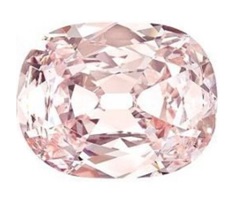 The Princie fancy intense pink diamond set a $40 million price record in 2013.
The Princie fancy intense pink diamond set a $40 million price record in 2013.
There are a few things you probably knew about diamonds without doing any indepth research – that is, everybody knows that diamonds are the hardest substance on Earth and they are the most expensive gemstone in the world.
As you learn more about diamonds, you will probably come across four main characteristics that define a diamond’s quality. These characteristics are also known as the “four C’s” and are cut, carat, clarity and last, but not least, color.
When you study a little more about what we understand by diamond color, you will see that a “colorless” diamond is usually preferred in the consumer market.
So, if a diamond ought to be colorless, why do we still care about pink diamonds? Well, let us talk about what fancy colored diamonds are and how pink diamonds are formed.
What Are Fancy Colored Diamonds?
A diamond’s color is typically graded on a scale of D to Z, where D represents a colorless state and Z represents a yellowish/brownish hue. When a yellowish/brownish diamond’s hue is more intense than a Z colored masterstone, it will be classified as a “fancy color diamond”.
Likewise, when the diamond has a different hue (e.g. pink, blue, red etc…), it would be categorized as a fancy color diamond if the coloration is sufficiently intense.
Interestingly, diamond colors can range from pink, through green and magenta to whatever color you would see in the entire spectrum, and even black. As a result, this makes the usual grading system of D-Z incompatible.
Instead, a grading system similar to that used in emeralds or sapphires is applied. Instead of alphabets, descriptive words like “fancy light pink” are used to describe the diamond’s color.
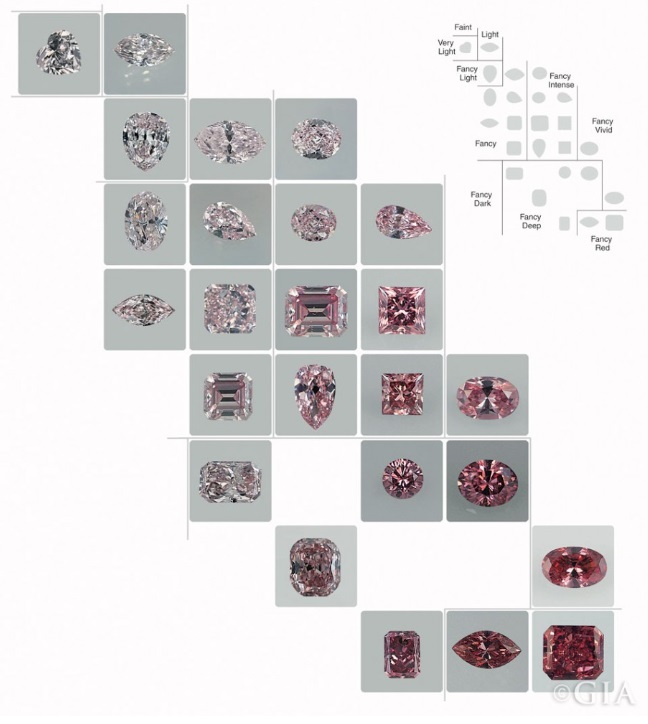
GIA reference color chart for pink diamonds showing color transitions.
How Are Diamonds Created in Nature?
If you had watched the movie, Superman, you would probably remember seeing him turn pieces of coal into diamonds using his hands. Well, that is just science fiction.
First of all, pieces of coal cannot be simply crushed and transformed into diamonds under high pressure forces. Secondly, the “raw material” for making diamonds are carbon deposits that are older and existed before any known vegetation responsible for today’s source of coal.
Diamonds are formed deep in the Earth’s mantle under extreme conditions which require a specific range of temperature and pressure. After formation, the rough diamonds are brought to the Earth’s surface by violent volcanic eruptions via kimberlite pipes where they are usually mined.
How Do Diamonds Get Their Color?
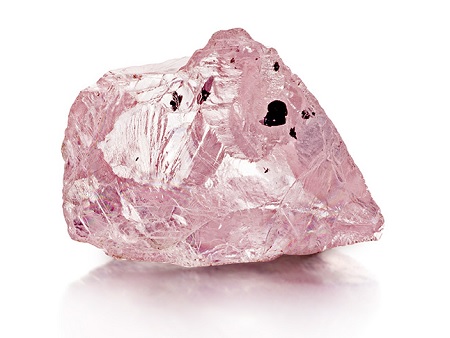
How a pink diamond looks when it is unpolished. Credits: GIA
There are a number of reasons that cause a diamond to display a certain color. The most common reason for coloration is due to the presence of trace elements in the diamond’s chemical composition.
For example, traces of nitrogen in a diamond’s composition give it a strong yellowish color. And since nitrogen is everywhere in Earth’s environment, most of the diamonds that are mined tend to be yellowish in color.
The presence of radiation sources during the formation process can permanently alter the diamond’s hue – usually yielding a greenish color. On the other hand, black diamonds are the result of severe graphite and iron inclusions which turn the diamond completely opaque.
What Makes Diamonds Pink And How Are They Formed?
1.09 carat fancy purplish pink diamond that costs $685,000.
While most other colored diamonds already had their origins and causes of color scientifically explained, one mystery that still puzzles scientists today is the origin of pink coloration in diamonds.
Around the world, pink diamonds can only be found at certain mines. Most notably, Australia’s Argyle mine is well known for producing rough diamonds with fantastic shades of pink (and prices too!). It is believed that pink diamonds didn’t start their growth process as pink.
Instead, scientists speculate that the stress and strain experienced by rough diamonds when they are in the Earth’s mantle causes the diamond’s lattice to be distorted. This distortion creates graining and causes pink color zones to occur within the diamond.
Despite the sophisticated lab analysis equipment available to scientists at the time of writing, no one has completely cracked the code on the mysterious color centers that induce pink hues in diamonds.
How Are Pink Diamonds Grown in the Laboratory?
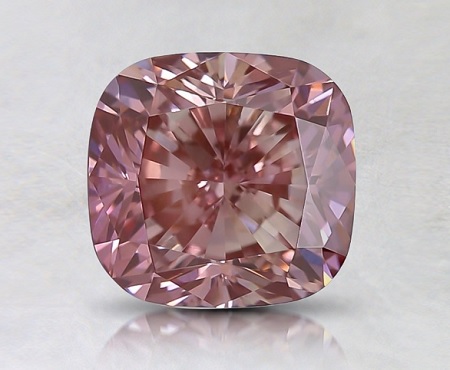
1.59 carat fancy pink cushion lab created diamond that costs $11,650.
Natural pink diamonds are very rare and they usually command astronomical prices. As a result, there are treatments and manufacturing processes that are used to artificially create pink diamonds at significantly lower costs.
Synthesizing diamonds in the lab is nothing new and methods like chemical vapor deposition (CVD) and high pressure, high-temperature (HPHT) processes have already been used since the 1940s.
In order to achieve the coloration of a pink diamond, a multi-step process is typically used. The first step of the process is to create a rough diamond via CVD or HPHT. At this stage, the rough diamond is usually light yellow in color.
The diamond is then subjected to neutron bombardment (irradiation) to introduce the pink hue into the diamond. Thereafter, an annealing process will heat up the diamond to even out the pink hue homogenously.
The resultant manmade pink diamonds would usually possess a color saturation from Fancy Faint Pink to Fancy Vivid Pink. On this note, I want to point out that a lab grown diamond has identical physical and chemical properties as a naturally mined diamond. The main differences lie in their value and people’s perception of authenticity.
With that, I hope you found this article useful and gained a better understanding of how pink diamonds are formed and made. Given the huge price differences between a natural and manmade diamond, which would you buy and why?
Leave a comment below to let me know. I would love to hear your thoughts!
Related Articles
Leave A Comment

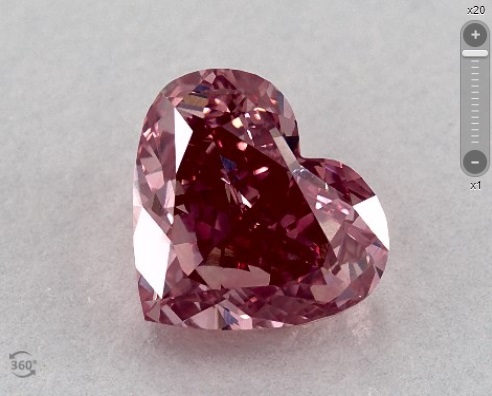
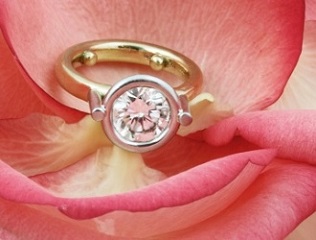
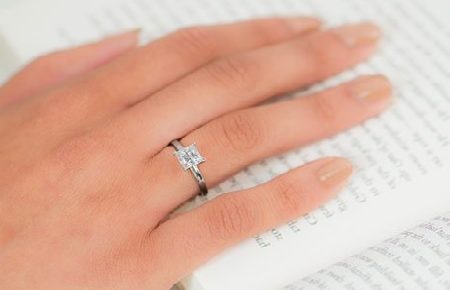
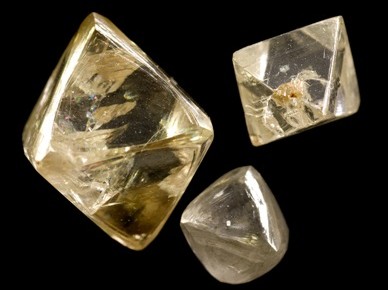
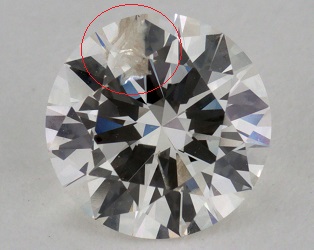









2 Comments
First of all, thank you very much for compiling all these articles on diamonds, when I asked for the ASET picture in some shops they just did not know what it was… I ended up buying a diamond from Brian Gavin:
https://www.briangavindiamonds.com/diamonds/diamond-details/0.820-d-vs2-round-diamond-ags-104087405069
The ASET is not crystal clean but there was a flash sale for cyber Monday and the Signature line was 20% off for the first 10 customers. So I think I had a good deal :-)
Now my question: I want a trilogy ring with a pair of pear shape pinks from Argyle. As you know they are very expensive. My budget for the pair is 6,500 AUD if I buy them here in Sydney, or 4,000 USD if online (import duty + GST will reach the top end of my budget).
All these pairs have a certificate of origin (Western Australia) but they don’t have GIA reports (but with the smallest stone at 0.07ct is it worth it?). They are all eye clean according to their vendors. Their grades have been given based on personnal opinion of the vendor so I don’t know if I can rely on them at 100%. Anyway, you can have so many different looking diamonds in the same grade I don’t give too much importance to it for the choice of the pair. They are supposed to have a Good cut and clarity between VS and SI.
I have 4 options:
Option 1: pair of 0.14ct, 5P, from here in Sydney (Pic Pink Sydney, the lighter pair at the bottom). I saw them in a jeweller’s atelier, they look really nice. The brilliance is better in real of course.
The other options come from Langerman, a Belgium cutter. They buy the Argyle diamonds from the mine and cut them in their facilities (pics Pink Belgium 1 and 2). The central diamond in pic Pink Belgium 1 is 0.55ct (mine is 0.82) to give an idea of the size of the pinks. And I am not planning to go to Belgium to see them.
Option 2: (id #3621) pair of 0.29ct, 4.62 x 2.88 x 1.84 mm and 4.49 x 2.71 x 1.88 mm, 6/7P, from langerman-diamonds.com
Option 3: pair of 0.29ct, 6/7P
Option 4: pair of 0.23ct, 5/6P. One of these stones has slight white inclusions but not visible at eye level, that’s why this pair is still in my budget (4,000 USD)
As you can see shapes and colors are quite different. You can see easily the bow tie effect on the picture Pink Belgium 2 but again with my budget I can’t have more.
My questions:
– Based on the fact that the setting will be in rose gold for these diamonds, which pair is the best for a harmonious ring? The idea is to get a final looking like the picture Full Ring Sydney from Calleija with the setting in the other picture. The 1st ring I found in love with was this one: calleija.com/pink-diamond-collection-rings/~r2326
I want to put a V claw at the pointed end and rose gold instead of yellow.
– I cannot find any pictures of a loose pink diamond and then the same set in rose gold. How the rose gold does enhance the color? Is it going to “hide” the blow tie? I saw quite a few rings with 7P diamonds in rose gold and the color look nice, not too pale. But I don’t know how they looked before as loose diamond.
– Before setting the pink diamonds, should I ask for a GIA report for insurance/value purpose?
It is really hard for me to choose from. I am tempted to go to Langerman because the stones will be bigger for the same price and they have a good reputation. Then: option 2 looks nice and stretched, could smoothe and melt with the band at the end. Option 3 has the best color match but is quite rounded. Finally, option 4 has more saturation and really looks pink even if the color and size are not an exact match.
What do you think? Should I also ask for a video from Langerman?
I reviewed the diamond at BGD and I can confirm this is definitely a great buy: https://www.briangavindiamonds.com/diamonds/diamond-details/0.820-d-vs2-round-diamond-ags-104087405069
When it comes to fancy color diamonds, you need to understand this: No GIA report = giant rip off. I repeat: NEVER buy a fancy color diamond without a GIA report. If the diamonds were really what the jewelers claim to be worth, they would have sent the stone to a grading lab like the GIA and that certificate would help it sell for more money.
So, why do you think they aren’t doing it? Well, that’s because the diamond is of inferior color quality and they are banking on consumers being stupid so that they can rip you off. With colored diamonds, I would never buy any without a GIA report and mind you, that’s coming from someone in the industry.
At the end of the day, it’s for your own protection as there are too many avenues for abuse and unsuspecting consumers often get taken for a ride.
If you want to get a pink diamond ring, read these links and be prepared to pay a pretty penny for them:
https://beyond4cs.com/fancy-colored/pink-diamond-engagement-rings/
https://beyond4cs.com/reviews/leibish/